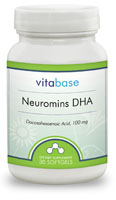| |
Docosahexaenoic acid (DHA) |
|
| Docosahexaenoic acid (DHA) is a highly unsaturated fatty acid that is greatly concentrated in rod photoreceptor cells. This omega-3 fatty acid is a major structural component of brain, nerve and retinal membranes. Docosahexaenoic acid is composed of 22 carbon atoms and six double bonds. Because the first double bond, as counted from the methyl terminus, is at position three, DHA belongs to the so-called omega-3 group. In recent years, DHA has attracted much attention because of its beneficial effect on human health. DHA has been associated with optimal memory function, visual activity, and maintaining a positive mental state. DHA is transformed to newborn babies through breast milk. This fatty acid plays a unique role in fetus development and is extremely important during the first few months of life. DHA is is the most abundant long chain polyunsaturated fatty acid (PUFA) in the grey matter of the brain. Omega-3-fatty acids in general are known to be beneficial in reducing the incidence of coronary heart disease. |
| |
Biological functions in human health |
|
|
Docosahexaenoic acid (DHA) is essential for the growth and functional development of the brain in infants. DHA is also required for maintenance of normal brain function in adults. DHA can reduce the level of blood triglycerides in humans, which may reduce the risk of heart disease. DHA's triglyceride-lowering property results from the combined effects of inhibition of lipogenesis and stimulation of fatty acid oxidation. Docosahexaenoic acid (DHA) is essential for the proper functioning of our brains as adults, and for the development of our nervous system and visual abilities during the first six months of life. DHA plays a crucial role in the growth and development of the central nervous system as well as visual functioning in infants. The inclusion of plentiful DHA in the diet improves learning ability, whereas deficiencies of DHA are associated with deficits in learning. DHA is taken up by the brain in preference to other fatty acids. The turnover of DHA in the brain is very fast, more so than is generally realized. The visual acuity of healthy, full-term, formula-fed infants is increased when their formula includes DHA. |
| |
Conditions and diseases associated with DHA deficiencies |
|
| DHA deficiencies are associated with foetal alcohol syndrome, attention deficit hyperactivity disorder, cystic fibrosis, phenylketonuria, unipolar depression, aggressive hostility, and adrenoleukodystrophy. Low levels of DHA have been associated with ADHD, Alzheimer's disease, and depression, among other diseases, and there is mounting evidence that DHA supplementation may be effective in combating such diseases. DHA deficiency plays an important role in a group of congenital diseases called peroxisomal disorders, which damage the protective covering (myelin) around nerves. Lack of sufficient DHA may be associated with impaired mental and visual functioning as well as attention-deficit hyperactivity disorder (ADHD) in children. DHA and its companion eicosapentaenoic acid, or EPA, are also important for coronary heart disease and prevention and, in particular, in the prevention of arrhythmic events. The association of DHA deficiency with depression is the reason for the robust positive correlation between depression and myocardial infarction. DHA and other omega-3 fatty acids may help reduce the risk of breast cancer. They may also suppress factors that can contribute to the growth of breast tumors. Individuals with a genetic disorder known as Zellweger syndrome are known to have low levels of DHA. |
| |
Dietary sources |
|
| DHA is present in fatty fish (salmon, tuna, mackerel) and mother's milk. At present, fish oil is the major source of DHA, but alternatively it may be produced by use of microorganisms. Marine microorganisms may contain large quantities of DHA and are considered a potential source of this important fatty acid. DHA is present at low levels in meat and eggs, but is not usually present in infant formulas. Most of the DHA in fish and other more complex organisms originates in microalgae of the genus Schizochytrium, and concentrates in organisms as it moves up the food chain. The richest dietary sources of DHA are the oils from cold water fish such as salmon, mackerel, herring, sardines, and other marine animals. DHA is also produced in the body, but it must be derived from alpha-linolenic acid, which is found in flaxseed oil. |
|
|
|
|
 Neuromins DHA is produced directly from micro algae under tightly controlled manufacturing conditions. There are no known side effects. DHA is naturally present in certain foods, and it behaves like any other fat in our digestive systems. The recommended dosage of Neuromins DHA is 100 milligrams per day for people who obtain some DHA from their diets. For those people who eat little or no DHA-rich foods, 200 milligrams of Neuromins DHA per day is recommended. Neuromins DHA does not contain other long-chain polyunsaturated fatty acids such as those that may be inappropriate for infants, children and certain adults. Neuromins DHA is also free of chemical pollutants and toxins that may be present in certain fish oils. Click here for more information.
Neuromins DHA is produced directly from micro algae under tightly controlled manufacturing conditions. There are no known side effects. DHA is naturally present in certain foods, and it behaves like any other fat in our digestive systems. The recommended dosage of Neuromins DHA is 100 milligrams per day for people who obtain some DHA from their diets. For those people who eat little or no DHA-rich foods, 200 milligrams of Neuromins DHA per day is recommended. Neuromins DHA does not contain other long-chain polyunsaturated fatty acids such as those that may be inappropriate for infants, children and certain adults. Neuromins DHA is also free of chemical pollutants and toxins that may be present in certain fish oils. Click here for more information.